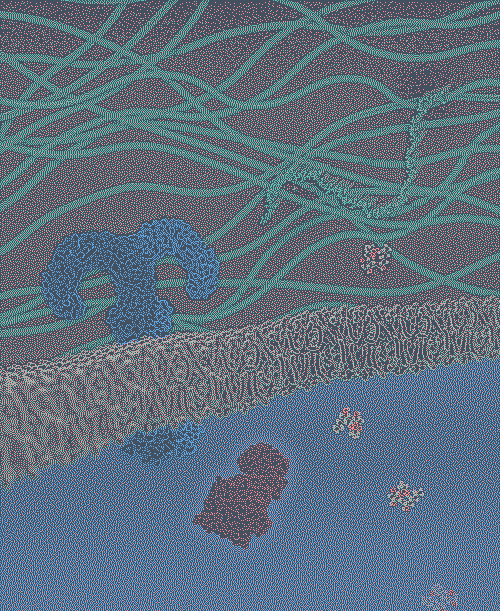"Probably the most important feature of a biomembrane is that it is a selectively permeable structure, which is essential for effective separation." — Wikipedia
"Viscosity retains an emphasis on resistance to changing form." — Nancy Tuana
“Bodies need water, but water also needs a body. Water is always sometime, someplace, somewhere. Even in our aqueous connections, bodies and their others/worlds are still differentiated. The question, then, of 'what is' is never sufficient. How is it? Where is it? When is it? Speed, rate, thickness, duration, mixture, contamination, blockage. If we are all bodies of water, then we are differentiated not so much by the 'what' as by the 'how.' But what are the specific mechanisms of this differentiation?
Attention to the mechanics of watery embodiment reveals that to connect bodies, water must travel across only partially permeable membranes. In an ocular-centric culture, some membranes, like human skin, give the illusion of impermeability. Still, we perspire, urinate, ingest, ejaculate, menstruate, lactate, breathe, cry. We take in the world, selectively, and send it flooding back out again. This selection is not a 'choice' made by our subjective, human selves; it is, as Nietzsche has taught us, an impersonal expression of phusis—nuances—affirmative material energies striving toward increasingly differentiated forms. Selection traverses other more subtle membranes, too—those that are either too ephemeral or too monumental to be perceived by us as such, yet choreograph our ways of being in relation: a gravitational threshold, a weather front, a wall of grief, a line on a map, equinox, a winter coat, death.
Nancy Tuana refers to this membrane logic as 'viscous porosity.' While the concept of fluidity emphasizes traversals across and between bodies, viscosity reminds us that there are still bodies—all different—that need to be accounted for. Viscosity draws attention to 'sites of resistance and opposition' rather than only 'a notion of open possibilities' that might suggest one indiscriminate flow. Despite the fact that we are all watery bodies, leaking into and sponging off one another, we resist total dissolution, material annihilation. Or more aptly, we postpone it: ashes to ashes, water to water.
At what point is the past overtaken by the present? What marks the definitive shift from one species to a 'new' one? Where does the host body end and the amniotic body begin? Our bodies are thresholds of both past and future. The precise material space-time of differentiation is only a matter of convenience, but any body still requires membranes to keep from being swept out to sea altogether.
There is always a risk of flooding.”*

* Neimanis, Astrida. "Hydrofeminism: Or, On Becoming a Body of Water." In Undutiful Daughters: Mobilizing Future Concepts, Bodies, and Subjectivities in Feminist Thought and Practice, edited by Henriette Gunkel, Chrysanthi Nigianni, and Fanny Söderbäck. New York: Palgrave Macmillan, 2012.